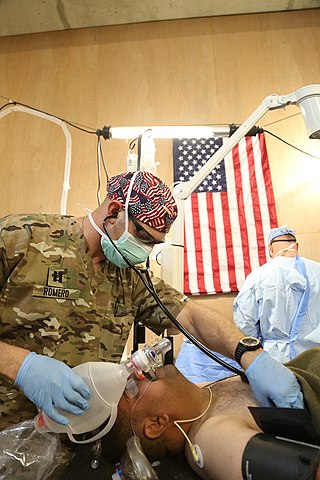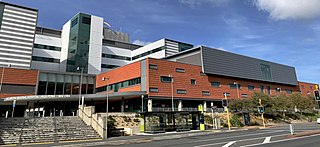
Fitzsimons Army Hospital, also known as Fitzsimons General Hospital, renamed Fitzsimons Army Medical Center in 1974, and Fitzsimons Building in 2018 was a U.S. Army facility located on 577 acres (234 ha) in Aurora, Colorado. The facility opened in 1918 and closed in 1996. The grounds were then redeveloped for civilian use as the Anschutz Medical Campus and the Fitzsimons Innovation Community.

A nurse anesthetist is an advanced practice nurse who administers anesthesia for surgery or other medical procedures. They are involved in the administration of anesthesia in a majority of countries, with varying levels of autonomy.

A Certified Registered Nurse Anesthetist (CRNA) is a type of advanced practice nurse who administers anesthesia in the United States. CRNAs account for approximately half of the anesthesia providers in the United States and are the main providers (80%) of anesthesia in rural America. Historically, nurse anesthetists have been providing anesthesia care to patients for over 150 years since the American Civil War and the CRNA credential came into existence in 1956. CRNA schools issue a doctorate of nursing anesthesia degree to nurses who have completed a program in anesthesia, which is roughly 3 years in length.

Michigan Medicine is the academic medical center of the University of Michigan, a public research university in Ann Arbor, Michigan.

Epworth HealthCare is a provider of acute medical, surgical and rehabilitation services in Melbourne, Australia. The group has four divisions: Epworth Richmond, Epworth Eastern, Epworth Cliveden, Epworth Freemasons and Epworth Geelong Epworth Rehabilitation, with rehabilitation sites at Richmond, Camberwell, Brighton and Geelong, Victoria. With over 1,200 beds and more than 4,000 staff, Epworth HealthCare is Victoria's largest not-for-profit private hospital group.

The Acland Hospital was a private nursing home and hospital in central North Oxford, England, located in a prominent position at the southern end of the Banbury Road. It was founded in memory of Sarah Acland, the wife of Sir Henry Acland, Regius Professor of Medicine at the University of Oxford. Following redevelopment it now serves as graduate accommodation for Keble College.

Wellington Hospital, also known as Wellington Regional Hospital, is the main hospital in Wellington, New Zealand, located south of the city centre in the suburb of Newtown. It is the main hospital run by Te Whatu Ora, Capital, Coast and Hutt Valley.
O'Connor Hospital is a hospital in San Jose, California, part of the Santa Clara County Health System. Located in the West San Carlos neighborhood of San Jose, O'Connor Hospital is one of the oldest hospitals in Santa Clara County, founded in 1889.

MelroseWakefield Hospital is a 174-bed non-profit hospital located in Melrose, Massachusetts. MelroseWakefield Hospital is affiliated with Lawrence Memorial Hospital of Medford. MelroseWakefield Hospital provides many different areas of patient care including surgery, cardiology, maternity, orthopedics, endoscopy, and emergency services.

Nurses in Canada practise in a wide variety of settings, with various levels of training and experience. They provide evidence-based care and educate their patients about health and disease.
The Riverside University Health System - Medical Center, or RUHS-MC, formerly Riverside County Regional Medical Center, or RCRMC, and also formerly Riverside General Hospital University Medical Center, or RGH UMC, is a public teaching hospital located at 26520 Cactus Avenue, Moreno Valley, California, United States, operated by the County of Riverside. It is classified as a Level I Trauma Center.

St. Luke's Hospital was a hospital building on a bluff overlooking downtown Davenport, Iowa, United States. It is listed on the Davenport Register of Historic Properties and the National Register of Historic Places. It has subsequently been torn down.

Kaiser Oakland Medical Center is a hospital in Oakland, California. It is located at the intersection of Broadway and West MacArthur Boulevard, immediately north of Downtown. It is the flagship hospital of Kaiser Permanente, the largest managed care organization in the United States, through its Kaiser Foundation Hospitals division.

Pacific Dispensary for Women and Children was a women's and children's hospital in San Francisco, California, US, founded in 1875, renamed Children's Hospital in 1877. Children's Hospital merged with Presbyterian Hospital in 1991, and within two years, a large joint physician group was established. It was subsequently acquired by California Pacific Medical Center.

The Transvaal Memorial Hospital for Children, based in Johannesburg, was the first dedicated children's hospital in South Africa when it opened in 1923. The hospital would remain open until 1978 when its functions were moved to the then newly opened Johannesburg General Hospital. The building is a heritage listed monument and parts of the building are currently used by community groups dedicated to the service of children.
Boston Emergency and General Hospital was an American hospital that ran on a cooperative basis and specialized in the treatment of the working class.

Louise M. Powell (1871–1943) was an American nurse and educator who led the University of Minnesota School of Nursing, during its formative years. During her tenure there (1910–1924), the university established a five-year baccalaureate nursing degree program. In honor of her achievements, the nurses residence hall was named for her in 1939. She was later dean of nursing at Western Reserve University.

National Homeopathic Hospital is a defunct American hospital. Located in Washington, D.C., it was established in 1881, and became Hahnemann Hospital in 1956.

Hahnemann Medical College of the Pacific was an American homeopathic medical school in San Francisco, California. It was established in 1881 as Hahnemann Medical College, with the first graduating class in 1884. During the period of 1888–1902, it was known as Hahnemann Hospital College of San Francisco. Its last name change, 1902–1915, was to Hahnemann Medical College of the Pacific.

The Wheeler Hospital was a historic hospital constructed in 1929, in Gilroy, California. The hospital was designed by California architect William Henry Weeks and funded by merchant Lin Walker Wheeler. The Wheeler Hospital was placed on the National Register of Historic Places on September 13, 1990. In 1990, the Wheeler Hospital merged with an elder care facility to establish the Wheeler Manor Senior Apartments.




















